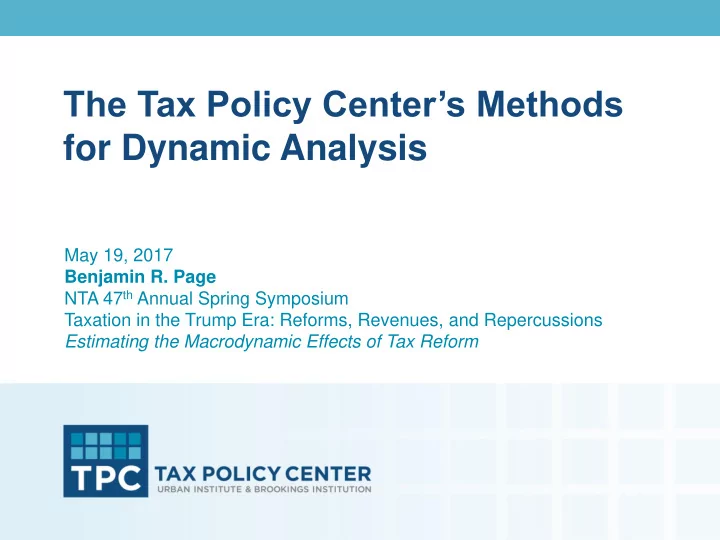

The Tax Policy Center’s Methods for Dynamic Analysis May 19, 2017 Benjamin R. Page NTA 47 th Annual Spring Symposium Taxation in the Trump Era: Reforms, Revenues, and Repercussions Estimating the Macrodynamic Effects of Tax Reform
Why Dynamic Analysis? To improve revenue estimates – Best guess of macro effects is in general not zero – Effects on estimates tend to be modest Because economic effects are important policy goals – Economic effects provide additional information about welfare effects – Effects on the economy tend to be modest www.taxpolicycenter.org 1
Main channels for macroeconomic effects Demand – After-tax incomes affect demand – Investment incentives affect demand Incentives – Marginal tax rates on labor income affect labor supply – Marginal tax rates on capital income affect saving Deficits – Increased deficits crowd out investment www.taxpolicycenter.org 2
Models used for TPC dynamic analysis TPC Keynesian Model – Aggregate variables, demand based – Output moves relative to potential TPC Neoclassical Model – Aggregate variables, supply based – Estimates potential output Penn Wharton Budget Model – Optimizing forward-looking households – Estimates potential output www.taxpolicycenter.org 3
Keynesian Model: Direct effects on demand With more after-tax income, consumers spend more – Lower-income households spend a larger share of their additional income than higher-income households – Baseline assumption: • Lowest quintile spends 90 cents of each additional dollar • Highest quintile spends just 55 cents of each additional dollar Investment incentives lead firms to invest more Higher wealth leads consumers to spend more www.taxpolicycenter.org 4
Keynesian Model: Indirect effects on demand Direct effect generates indirect effects that can add to or offset the direct effect – On the plus side, increased demand can lead to increased hiring, investment spending, or consumption spending – On the minus side, increased demand could lead to higher interest rates, reducing investment and consumer spending www.taxpolicycenter.org 5
Keynesian Model: Indirect effects on demand In normal economic times the Fed offsets expansionary tax policy by raising rates to prevent an increase in inflation Indirect effects offset half of direct effects - Multiplier of 0.5 on changes in direct demand In deep recession the Fed will not change rates, leading to positive indirect effects, adding 50 percent to direct effects - Multiplier of 1.5 on changes in direct demand www.taxpolicycenter.org 6
Neoclassical Model Core potential output determined by - Labor hours - Capital stock - Total factor productivity Cobb-Douglas production function - Capital share = 0.3 No explicit forward looking www.taxpolicycenter.org 7
Neoclassical Model: Labor hours After-tax wage - Elasticity of labor hours to the after-tax wage = 0.24 After-tax income - Elasticity of labor hours to after-tax inomce = -0.05 Effects calculated on an aggregate level www.taxpolicycenter.org 8
Neoclassical Model: Capital stock After-tax rate of return – Depends on pretax rate of return, marginal tax rate on capital income, and expensing ratio – Interest elasticity of saving = 0.2 Deficit – Private saving offset = 0.43 – Capital inflow offset = 0.24 – Additional dollar of deficit crowds out 33 cents of output www.taxpolicycenter.org 9
Keynesian and Neoclassical combined estimates Results of the two models combined using a weighted average Weights on the neoclassical model of 0, 0.25, 0.5, 0.75, and 1 over the first five years after implementation of a policy www.taxpolicycenter.org 10
Penn Wharton Budget Model Overlapping generations model Simulates economic and budgetary outcomes from household decisions about work and saving Uncertain working ability and longevity Households forward-looking - Make decisions based on current and future policies and economic outcomes Can model unbalanced tax reforms through 2040 www.taxpolicycenter.org 11
Penn Wharton Budget Model: Base parameters Frisch elasticity of labor supply = 0.5 Elasticity of intertemporal substitution = 0.5 Depreciation rate = 0.085 Population growth rate = 1.2 percent Weight on open economy results = 0.4 www.taxpolicycenter.org 12
Penn Wharton Budget Model Available online at http://www.budgetmodel.wharton.upenn.edu User can alter assumptions for open economy weight, labor supply elasticity, saving elasticity, and federal outlays www.taxpolicycenter.org 13
THANK YOU For more information please contact: Benjamin R Page bpage@urban.org
Recommend
More recommend